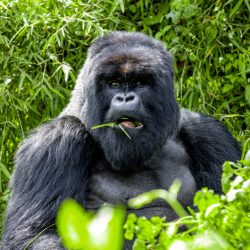Building a Future in Bukima
Blog | 4/02/10
Goma bustles. Goma hustles. Goma tussles with poverty and the effects of a devastating decade plus war in this resource rich sector of Eastern Democratic Republic of Congo, whose dying flame stubbornly refuses to be snuffed out completely. I am back here to check on the progress of IGCP’s conservation efforts in and around Virunga National Park since the withdrawal of rebel armies a year ago, and the resultant fragile peace that has seeped through cracks of chaos in the concrete and thrust itself to the sky like a fast growing weed. Some people see poverty, but today I see normal life. Hustle and bustle is good for Goma, I surmise, and in turn good for mountain gorilla conservation. Yes, severe, and often intractable, problems remain, but I am filled with hope and peace as we break through the crowds and bump out of town on the main lava rock rutted road.
My mission today is to take a look at the new building IGCP helped construct at the Bukima Ranger Post in the Park. Bukima is a windswept field of flowers high in the hills which run up to Mikeno Volcano. Its views are without equal, and it also serves as the starting point for tracking two gorilla families: the compact Humba and much larger populated Kabirizi. Though difficult to reach, Bukima is hoping to attract more visitors since gorilla tourism re-opened in the Park in May of last year. A new building may admittedly be a mundane aside to many, but for IGCP and the Park it is a living representation of progress: the fact we were even able to complete such a project a little more than a year after the land it stands on and the people who lived nearby was being scarred on a daily basis by rebel troops who had overrun the area, is part small miracle and a giant heaping of dedication, passion and hard work.
I can see the results of this tenacious ability to bounce back and move on before I even make it to Bukima. As we pass the spewing cone of still active Nyirgongo Volcano I count zero plumes of smoke rising lazily from its forested slopes. A year ago, during my first pass here there were many – rebel campgrounds or perhaps illegal charcoal burning operations. On my second pass there were fewer. By last November there was less than handful. “It’s because of Emmanuel’s (Virunga NP Chief Warden) dedicated patrols”, the driver Jerome instinctively answers before I am even able to blurt out my question. There were times when the Park Service seemed down for the count, such as when rebel soldiers ran roughshod over Park headquarters at Rumangabo in late 2008, capturing it and forcing many to flee into the forests with only the clothes on their backs. But unyielding support from IGCP and others, along with a strong new Chief Warden, has enabled the ranger corps to not only regroup, but thrive.
I see more evidence of this progress as we sputter towards Bukima on an impossible road. Here, at a sharp corner that three months ago only contained weed choked grass, a new school has risen, its fresh gray concrete anchoring firmly into the deep brown earth. Spindly stalks of the household staple sorghum, with their bushy moptops of pink and reddish berries, sway in the breeze, ripe for harvest. Healthy kids are everywhere, smiling but coy as they shout out requests for used water bottles and thrust their thumbs up with the cry “Jambo!” (Hello!).
By the time we reach the ranger post, gray clouds have settled into a permanent frown in the milky sky. The building, with its bright red painted doors, breaks up the opacity, jutting out into the valley below perched on a small ridge directly facing the approach road. Yes, a building is a building, but one look at the thrown together clapboard shack the rangers have been using as their main barracks and office, and its importance becomes even more obvious. Good infrastructure, and the amenable work spaces that go with it, is the vital foundation to all the hard work that surrounds it. In the case of Virunga National Park, just establishing a permanent presence on ground once rife with conflict is huge step forward for gorilla and park conservation, as well as the communities. Martin Kazarezi, the ranger in charge today, seconds my thoughts. “We are very happy to see this new building. It is stable and will last a long time….perhaps a hundred years or more!”
I take a short walk to the campsite, and realize that in the stillness of this high mountain hamlet, life, as in Goma, is everywhere. Thousands of delicate white flowers blown off their stems twinkle the rough earth at my feet, like pocket stars gathering for a feast of bright light. A step into the tall sharp grass reveals the tiniest of grasshoppers, bright yellow and not bigger than a thumbnail, clinging to the whistling glades. The clipped musical chirps of the black and white pied wagtail, a common bird in the area, drift on the rings of the steadily swirling wind.
For me this is landscape of no equal, where the wildflowers truly run wild and the volcanoes’ rocky tops break through their densely forested peaks to grasp at the ever present clouds. But to the gorillas, the rangers and the local families, this is simply “home”. Working with these residents to establish peace and prosperity – a permanent presence – here through building and other projects is the most important work we can undertake in keeping this special place wild and growing. Moving forward, as it should be.





